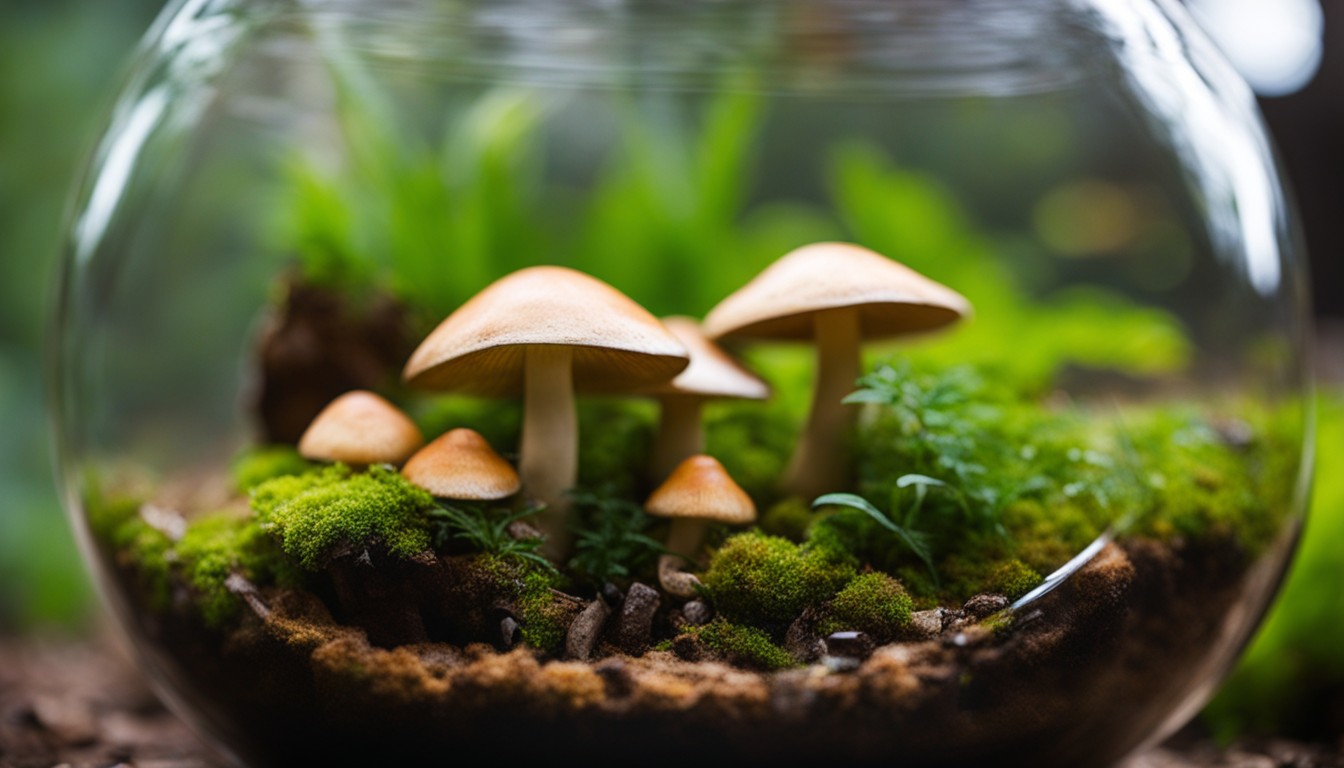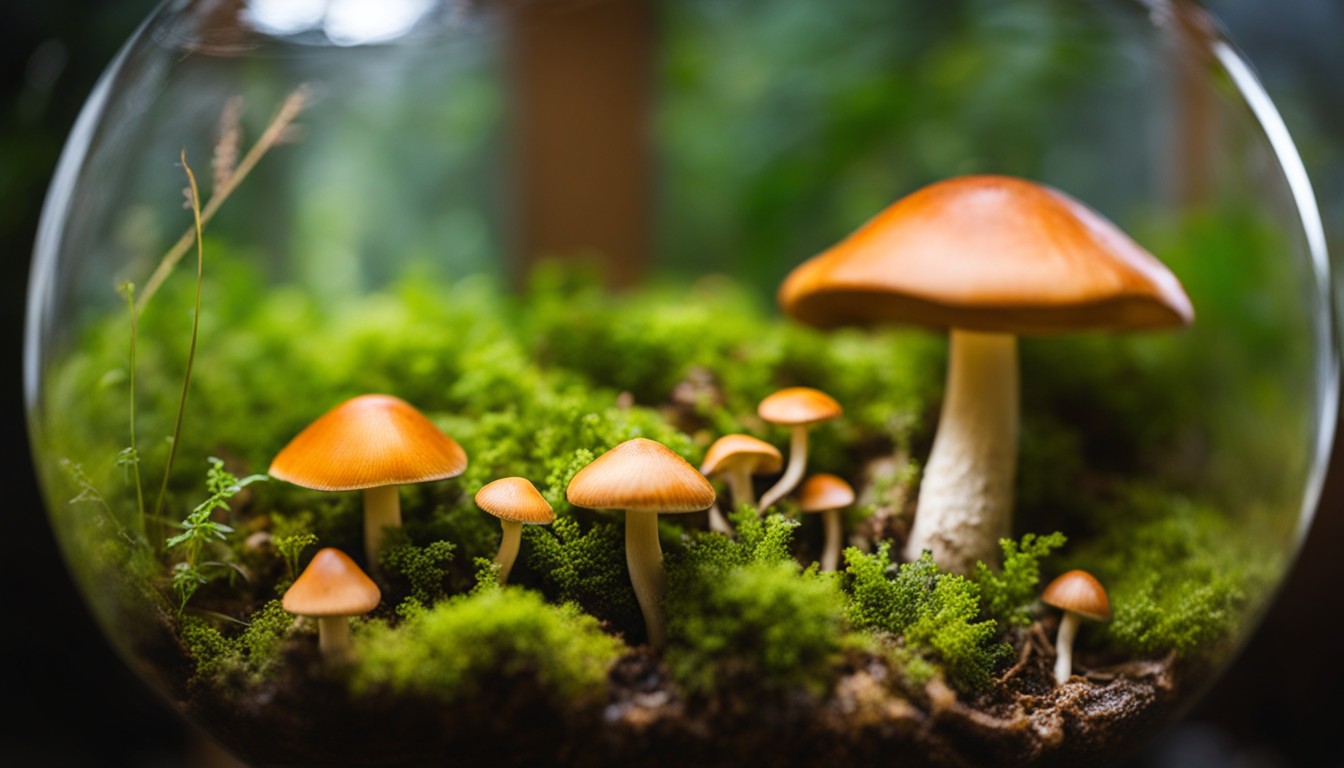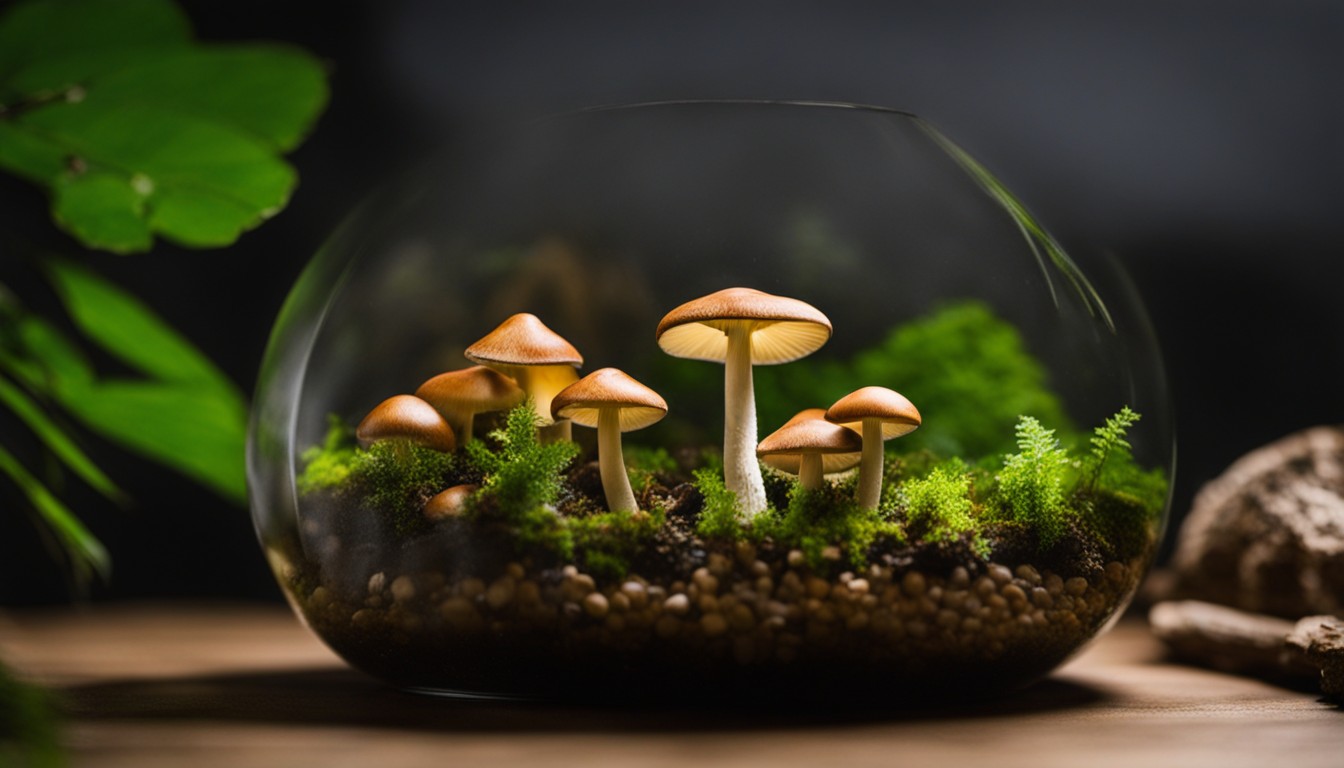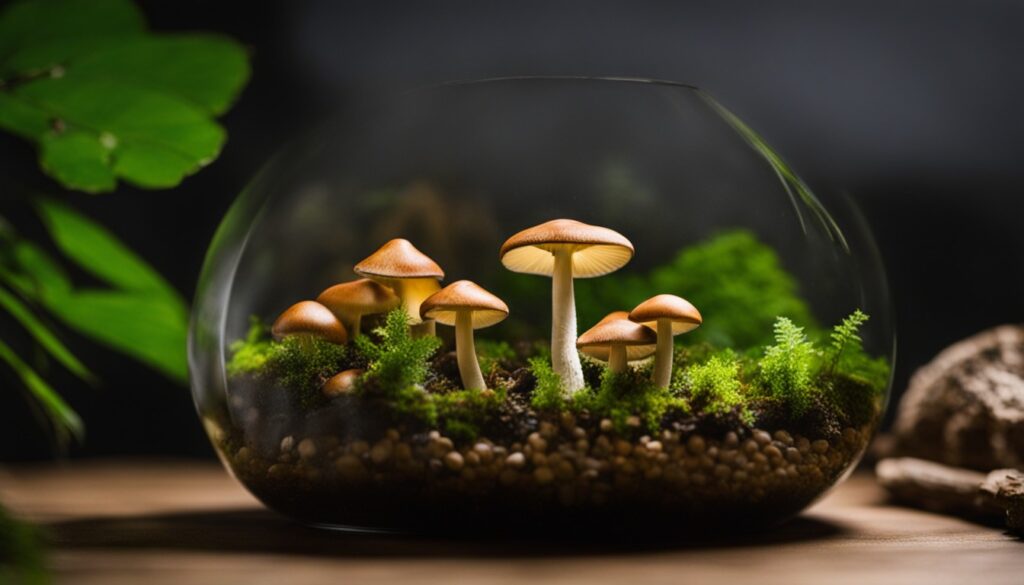Terrariums offer a unique and controlled environment for growing mushrooms indoors. From selecting the right terrarium container to choosing the ideal mushroom species, this comprehensive guide covers everything you need to know to successfully cultivate mushrooms in a terrarium. Learn about the necessary materials, optimal temperature and humidity conditions, and step-by-step instructions for preparing the substrate and inoculating it with mushroom spawn. Discover valuable tips for maintaining the terrarium, preventing contamination, and harvesting your own homegrown mushrooms. Whether you’re a beginner or an experienced cultivator, this guide will help you create a thriving mushroom terrarium in your own home. So roll up your sleeves and get ready to embark on a fascinating and rewarding mushroom-growing journey!
Key takeaway: Cultivating mushrooms in a terrarium is a fulfilling and enjoyable indoor gardening activity that allows you to harvest your own fresh and nutritious mushrooms. With proper knowledge and attention to detail, you can create a successful mushroom terrarium and enjoy the benefits of homegrown fungi.
Choosing the Right Terrarium for Mushroom Cultivation
Assessing the benefits of different terrarium materials for mushroom cultivation unveils that glass and plastic stand out, due to their transparency and ease of sterilization. These materials foster fungal growth while allowing observation of the cultivation process.
The selection of a suitable terrarium emerges as a critical step in indoor mushroom farming. Choosing appropriately can facilitate climate control, leading to successful mushroom growth and yielding a significant return on your investment.
Factors to Consider
In selecting the appropriate terrarium for mushroom growth, critical elements such as humidity, temperature, and light exposure play vital roles in your decision-making process.
- Factoring in the variations of your environmental climate when considering terrarium style and size.
- Paying attention to a terrarium’s ability to maintain high humidity levels, imperative for successful mushroom cultivation.
- Choosing terrarium material which can withstand consistent warm temperatures, preferred by many common mushroom species.
- Ensuring terrarium structure allows for customizable light control as different mushroom varieties have varied light exposure needs.
- Appreciating the role of light exposure in influencing the growth and fruiting patterns of your mushrooms.
Terrarium Size
Terrarium size plays a critical role in successful mushroom cultivation, profoundly influencing factors such as growth pattern, moisture control, and spatial distribution.
- Variations in terrarium dimensions can lead to discrepancies in mushrooms’ growth patterns.
- A large terrarium offers more space for mushroom expansion but may require additional measures for humidity regulation.
- A smaller terrarium is easier to manage for beginners but limits the mushroom yield.
- Choosing the right size can optimize the cultivation process, ensuring healthy growth and high yields.
Preparing the Terrarium for Mushroom Cultivation
In the art of terrarium preparation, cleanliness and proper environment establishment play a crucial role. It begins with sterilization, ensuring the container is free from microorganisms that could jeopardize the fungi’s growth.
Precise control of humidity, temperature, light, and air flow is crucial in terrarium preparation, significantly affecting the overall mushroom cultivation success.
After sterilizing the terrarium, keen practices to foster a conducive growth environment follow. This includes regulating the humidity and temperature within the terrarium, as well as assuring the provision of adequate light and air flow.
Creating the Ideal Environment
The primary goal when setting up a terrarium is to mimic the mushrooms’ natural habitat as closely as possible. Understanding and catering to their unique lifecycle needs will ensure a successful transposition from the wild to an indoor environment.
- Ensure the terrarium is moist but not waterlogged, achieving the perfect balance of humidity
- Regulate temperature to maintain an optimal range for mushroom growth, generally between 55 and 75 degrees Fahrenheit
- Provide a substrate akin to the mushrooms’ natural growth medium, such as compost, straw or wood chips
- Consider light requirements, as different species prefer varying levels of light exposure
- Simulate fresh air exchange by providing ventilation, crucial for the mushrooms’ respiration process
- Cater to the mushrooms’ appetite for darkness during certain stages of their lifecycle
Sterilizing the Terrarium
A sterilized terrarium plays a crucial role in successful mushroom cultivation as it ensures an environment free from competing bacteria and fungi that may impede mushroom growth.
- Start by thoroughly washing the terrarium with hot, soapy water.
- Rinse thoroughly to remove soap residue.
- Wipe it dry using a clean towel.
- Apply a layer of isopropyl alcohol (70 to 90%) on all interior surfaces.
- Let it air dry completely before proceeding to the next step.
Selecting the Right Mushroom Species

To guarantee success in cultivating fungi within a terrarium, the right mushroom species must be chosen. This critical stage requires consideration of each species’ distinct habitat needs, growth pace and response to controlled environments.
A comprehensive understanding of different mushroom species’ unique requirements is pivotal for setting up an effective terrarium. Conditions, such as temperature range, acidity level, and humidity preference, vary widely across mushroom types and must be catered to accordingly.
Mushroom Varieties Suitable for Terrarium Cultivation
Identifying the mushroom species best suited for terrarium cultivation can set the stage for successful indoor fungi farming – an intersection of science, art, and gastronomy. Certain varieties simply thrive under these controlled conditions.
- Enoki mushrooms, known for their delicate, long stems and small, white caps.
- Button or white mushrooms, the most cultivated mushrooms worldwide.
- Shiitake mushrooms, with their unique texture and full-bodied flavor.
- Oyster mushrooms, appreciated not only for their taste but also for their beauty.
- Crimini (baby bella) or portobello mushrooms, excellent varieties for the gourmet gardener who loves a hearty, meaty flavor.
Considerations for Beginners
Embarking on the journey of indoor mushroom cultivation, beginners should prioritize understanding terrarium conditions, choosing appropriate mushroom species, and monitoring growth. The uniqueness of terrarium cultivation demands attentiveness and precision, yet it’s a delightful, rewarding practice.
- Research suitable species such as oyster or shiitake mushrooms for easier cultivation
- Ensure a clean, sterile environment to reduce potential contamination
- Understand natural mushroom life cycles to better anticipate growth stages
- Monitor temperature and humidity levels consistently
- Be patient and observe the growth patterns in your terrarium
- Learn the signs of healthy mycelium growth
Obtaining Mushroom Spawn

To secure the finest mushroom spawn, aim to acquire it from reputable suppliers, such as ‘North Spore’, ‘Urban Farm’, or ‘Field and Forest Products’. Established suppliers typically deliver high-quality product consistent with healthful, contaminant-free growth.
Obtaining excellent mushroom spawn necessitates careful sourcing; ensuring your supplier uses quality-control methodologies and can provide your desired fungus variety. Additionally, preference should be given to suppliers able to offer advice on the best suit for your terrarium relative to your expertise level.
Purchasing Spawn vs. Making Your Own
Deciding between purchasing mushroom spawn and producing your own impacts the success of terrarium fungi cultivation. Store-bought spawn offers quality with less hassle, while crafting your own gives control but requires more skill and resources.
Crafting your own spawn for terrarium fungi growth opens opportunities for experimentation but also potentially invites contamination. Despite being laborious and complicated, it allows customization of strains. Conversely, buying spawn, although more expensive, eliminates preparation work, ensuring contaminant-free growth medium.
Where to Source High-Quality Spawn
Dedicated suppliers on reliable platforms such as Fungi Perfecti and North Spore offer superior, lab-tested mushroom spawn, setting growers on a path to successful cultivation. They’re distinguished by their unwavering commitment to quality and biodiversity.
Trusted sources, beyond mushroom-centric websites, include local nurseries or agricultural suppliers. Always prioritize suppliers where freshness and quality assurance is emphatically promised and lab-tested genetics are used.
Navigating the selection of high-quality spawn involves few criteria: look for signs of robust, healthy mycelium and avoid any that presents signs of contamination. A solid understanding of the mushroom variety intended for cultivation can aid you significantly in making an enlightened choice.
Preparing the Growth Medium
Unlocking the root of robust mushroom growth starts with understanding the growth medium. The secret lies in finding the right substrate; a combination of organic materials just rich enough to supply mushrooms with the necessary nutrients.
When preparing an effective growth medium for terrarium mushrooms, ensuring cleanliness is paramount. Sterilize the substrate to eliminate competing organisms—this step might make the difference between a lush yield and no growth at all.
Choosing the Substrate
A mushroom’s home is its substrate – the right choice is crucial for bountiful yields. Materials such as straw, hardwood pellets, or coffee grounds offer a rich foundation for the fungi.
The substrate in mushroom terrarium cultivation does more than just serve as a home; it directly influences growth rate, yield, and overall health. Appropriate substrate selection is undeniably a significant step in indoor mushroom cultivation.
Sterilizing and Preparing the Substrate
For an efficient substrate sterilization, consider steam sterilization or the use of a pressure cooker. These proven techniques ensure the elimination of harmful microorganisms that might compete with your mushrooms.
As for a masterclass on preparing the substrate, don’t overlook the importance of balancing moisture content. Too dry or too wet may inhibit mushroom growth. Remember to sterilize after preparation – this way, the substrate is primed for successful terrarium-based mushroom cultivation.
Inoculating the Terrarium
Inoculation serves as a crucial step in indoor fungi cultivation, effectively introducing the mushroom spawn into the substrate inside the terrarium. It sets the stage for mycelium growth, an intricate network of filamentous cells that eventually lead to the formation of mushrooms.
To carefully inoculate your terrarium, first ensure the substrate is ideally moist and at a sterile condition. Then, gently but thoroughly mix the mushroom spawn with the substrate. Ensuring even distribution promotes a healthy and bountiful yield, as it decreases competition and maximizes the growth potential of the spawn.
The Inoculation Process
Inoculating a terrarium with mushroom spawn is more than simple scattering. It’s akin to an intricate dance where both the dance floor and dancers must synchronize perfectly. Understanding the steps involved in this process enhances your chances of cultivating a bountiful yield of fungi within your home.
Demystifying the inoculation procedure begins with familiarizing yourself with the substrates and mushroom spawn. The substrate serves as the nurturing ground where the spawn will thrive, multiply and metamorphose into mature crops.
Inoculation is a two-step process that involves mixing the spawn with a substrate then transferring the mixture back into the terrarium. It’s essential to be gentle during this process to prevent any damage to the spawn which is crucial for a successful yield.
Upon completion of the spawn-substrate mixture, the terrarium should be sealed to create a conducive environment for fungal growth and prevent contamination. This delicate balance of conditions fuels the transformation of the spawn into flourishing fungal bodies.
Patience is cardinal once inoculation is over. Mushroom cultivation is a slow process requiring minimal disturbance and optimal conditions. Consistent monitoring for any signs of contamination is paramount for ensuring a healthy and bountiful yield.
Ensuring Proper Placement of Spawn
Strategic placement of mushroom spawn is fundamental to creating a flourishing terrarium. Positioning the spawn correctly encourages an efficient and even distribution of mushrooms, paving the way for robust growth across the entire area.
Equally important is the depth at which the spawn should be placed. Introducing spawn too near the surface may result in drying out, while setting it too deep can hinder its ability to sprout. Aim for a balanced placement: not too deep, not too shallow.
Another essential tip is to ensure the spawn is distributed evenly over the surface of the substrate. This even dispersal optimizes the mycelium’s spread, facilitating a comprehensive colonization of the substrate and promoting a prolific mushroom growth.
Maintaining the Terrarium and Encouraging Growth

Diligent terrarium upkeep greatly influences mushroom cultivation success. Regular temperature, humidity checks, and visual inspections for any signs of contamination are crucial for healthy fungal growth.
To stimulate fungal growth, a comprehensive terrarium maintenance schedule must be followed. This includes monitoring light levels to avoid extremes, ensuring adequate ventilation, and adjusting conditions as necessary for different mushroom varieties.
Maintaining Optimal Temperature and Humidity
The well-being of your fungi relies heavily on the equilibrium of temperature and humidity within your terrarium. Make it a point to monitor these conditions frequently ensuring they remain within an optimal threshold for your mushroom species.
A significant aspect of successfully cultivating mushrooms in a terrarium is mastering the climate. Striking a balance between temperature and humidity can make an immense difference to your yield.
The right temperature and humidity steer your fungi down the path of prosperity. Hence, paying meticulous attention to these climate elements in your terrarium facilitates the cultivation of robust and healthy mushrooms.
Providing Adequate Lighting and Airflow
Light intensity and air circulation dramatically influence your terrarium mushrooms’ health and vigour, playing an integral part in the growth process. Mushrooms don’t photosynthesize like plants, however, indirect light can guide their growth direction, while excessive light can lead to drying, inhibiting growth.
An art of regulating light sources and ventilation, optimizing fungi health in indoor cultivation is a delicate balance. A dimly lit room or a diffused light source promotes healthy growth. Ventilation supports the expulsion of carbon dioxide, a mushroom’s waste product, and brings in fresh, oxygen-rich air.
Provide your terrarium with brief periods of indirect artificial light daily to direct mushroom growth, and invest in a terrarium with adjustable airflow vents for proper air exchange. Remember, conditions that are too dry or bright are just as detrimental to mushrooms as those that lack light or air circulation.
Harvesting and Enjoying Your Mushroom Yield
Curiosity towards when and how to harvest mushrooms is common among beginner cultivators. Monitor their growth carefully—once the caps fully open and the gills underneath begin to brown slightly, it’s time to gently twist and pull the mushrooms free.
The joy of cultivating mushrooms extends beyond the terrarium. Whether sautéed in a stir fry or mixed into a savory mushroom soup, homegrown fungi provide a freshness that store-bought varieties often lack. Do remember, safe culinary practice involves comprehensive knowledge about the specific mushroom species before you integrate them into your meals.
Determining When to Harvest
Mastering the perfect harvest time requires a keen eye for recognizing mature fungi in a terrarium. Subtle changes in color, cap shape, and veil remnants are key indicators of a mushroom’s maturity.
Specific mushroom varieties have distinct signs for maturity. For instance, most mushroom caps flatten and expand at maturity. However, the veil under the cap, which protects the gills, usually breaks. This signifies the mushroom is ready for harvesting.
Deciphering such indicators ensures a timely and fruitful harvest. Delayed harvest in terrarium cultivation may lead to overgrown, infertile mushrooms, or worse, mushroom spore dispersal, which affects future cultivation.
Each mushroom species differ in their maturity signs, adding to the complexity. By understanding these distinct symptoms, one can accurately determine the opportune moment to harvest, maximizing yield and quality of the home-grown mushrooms.
Harvesting Techniques
The first successful mushroom harvest is the crowning achievement in terrarium cultivation; thus, employing safe and efficient techniques is fundamental. It’s essential to twist and pull the fruiting bodies gently to prevent damage to the underlying mycelium, thereby ensuring future yields.
To maintain the health of your cultivated terrarium, alleviate any pressure applied to the mycelium during harvesting. Carefully cutting the mushrooms at the base with a sterilized knife can provide an ideal solution, leaving the mycelium undisturbed.
Avoiding unnecessary damage to the mycelium during harvesting not only ensures sustainable mushroom cultivation but also encourages a healthy terrarium ecosystem. Working with a gentle touch and using appropriate tools ensures the continual, robust growth of your indoor fungal garden.
Delicious Recipes to Try with Your Homegrown Mushrooms
Encapsulating the exhilarating sensation of mushroom foraging at home, culinary creations with terrarium mushrooms offer unparalleled satisfaction and delight. Transform your freshly harvested fungi into gratifying meals, revealing a whole new gastronomic adventure with each plate.
With terrarium harvest at your fingertips, unleash your culinary prowess to translate these earthy delights into gourmet wonders. Experiment with various homegrown mushrooms in your favorite recipes – stroganoffs, stir-fries, soups, or pizzas, and enjoy the freshness and richness they bring.
Homegrown mushrooms, embedded with your care and patience, deserve to star in your kitchen. Celebrate the fruits of your toil with recipe ideas tailored for your harvest. Explore the myriad possibilities from earthy appetizers to hearty entrees, and witness your homegrown mushrooms transform successfully into a culinary masterpiece.
FAQ: Mushrooms in Terrarium
Welcome to the FAQ section for cultivating mushrooms in a terrarium! Here, you’ll find answers to commonly asked questions about growing fungi indoors.
How do I choose the right terrarium container?
When selecting a terrarium container for growing mushrooms, opt for one that provides ample ventilation, a tight-fitting lid, and is made of transparent glass or plastic to allow sunlight to penetrate.
What mushroom species are suitable for terrarium cultivation?
Several mushroom species are well-suited for terrarium cultivation, including oyster mushrooms (Pleurotus ostreatus), shiitake mushrooms (Lentinula edodes), and lion’s mane mushrooms (Hericium erinaceus). Research the specific requirements of your chosen species before getting started.
What are the ideal temperature and humidity conditions for a mushroom terrarium?
Most mushrooms thrive in temperatures around 65-75°F (18-24°C) and humidity levels between 80-90%. It’s crucial to maintain these conditions consistently within your terrarium to promote healthy mushroom growth.
How do I prepare the substrate for mushroom cultivation?
To prepare the substrate, mix together a combination of organic materials such as straw, sawdust, or coffee grounds, and sterilize it to eliminate any potential contaminants. This substrate acts as a nutritious medium for the mushrooms to grow.
What is mushroom spawn, and how do I use it?
Mushroom spawn refers to the mycelium of the mushroom species you intend to grow. You can purchase spawn from reputable suppliers. Simply mix the spawn into the prepared substrate and evenly distribute it to provide a foundation for mushroom growth.
How do I maintain the terrarium and prevent contamination?
Maintain cleanliness by regularly sanitizing your terrarium and tools used in cultivation. Control humidity levels, provide proper airflow, and monitor for signs of contamination, such as mold growth or unpleasant odors. Promptly remove any contaminated materials to prevent its spread.
When can I harvest mushrooms from the terrarium?
The harvesting time varies depending on the mushroom species, but generally, mushrooms are ready to be harvested when their caps have fully expanded and just before the spore release. Follow specific guidelines for each mushroom species to maximize their flavor, nutrition, and potency.
Remember to consult additional resources and guides for a more comprehensive understanding of mushroom cultivation in terrariums. Happy growing!

